NSIF-FS10


Multiple Trait Selection for Pork Improvement
Authors: T. S. Stewart, Purdue University; S. M. Neal, Ohio State
University Agricultural Technical Institute; K. M. Irvin, Ohio State
University,
Reviewers: Jeff Chewning, The Pork Group Inc. Rogers, AR;
Don
Levis, University of Nebraska, Lincoln, NE; Fields Gunsett, Genetic
Improvement Services, Newton Grove, NC
Introduction
One of the most important decisions breeders make
is choosing which traits to improve in their herds. Breeders must decide
among numerous traits of economic importance and determine whether to
improve performance a small amount in several traits or make larger
amounts of improvement in fewer traits.
Background
Selection is similar to developing a financial
budget when one has a limited amount of money to spend each month. One can
buy one or two large items or smaller quantities of more items. Just as
monthly income is limited, selection intensity is also limited. The
breeder must decide how many traits to attempt to improve and how much
selection pressure to budget to each trait. One trait might be greatly
improved by applying all the selection pressure to it, or several traits
might be improved to a lesser degree each by "spreading" the selection
intensity around.
Similar to compounding interest, genetic
improvements accumulate over generations and hence affect the performance
of the herd in subsequent generations. And like investment opportunities,
returns resulting from selection are not the same for all traits. Expected
response to selection is proportional to the heritability and selection
differential of that trait. Traits with higher heritabilities have a
greater response with a given selection intensity than traits with lower
heritabilities; however, not all traits have the same economic value.
So, while progress may be more rapid in a trait with a high heritability,
the value of the progress may be greater for a trait with a lower
heritability. The challenge to breeders is to determine which traits to
improve based on the heritability and the economic values among them. To
make the task a bit harder, remember genetic improvement is cumulative
over generations. The typical generation interval in pigs is about three
years. So, when identifying the list of traits and their relative values,
it's their importance and value in six to nine years, not today, that is
the real challenge.
This fact sheet focuses on the concepts of
developing a selection objective and the selection criterion used to
obtain that objective. The selection objective is a description of the
traits you wish to improve and their relative importance to herd
profitability. The selection criterion is the method of evaluating each
animal, relative to the selection objective, for use in deciding which
animals to retain for breeding. Ideally, the selection criterion
accurately identities those breeding animals that advance a herd toward
the desired objective most rapidly.
Frequently mentioned traits of high-economic
importance to include in selection objectives are litter size, 21-day
litter weight, days to market, feed efficiency, and backfat thickness.
Other traits of interest include carcass lean percent, meat quality,
libido, rebreeding interval, longevity, structural soundness, and disease
resistance. It is not practical to attempt to improve all these traits
simultaneously. A breeder must prioritize traits to include in selection
objectives and decide which are the most important to improve. As the
number of traits chosen for selection increases, the genetic change in
each individual trait decreases. As a result, it is critical to identify
those traits, that when improved, result in the greatest economic gain.
Once the selection objective is chosen, breeders
should apply the appropriate selection criteria over a period of years to
achieve a positive change in herd performance. The selection criterion may
include any number of traits and methods of selection. Develop the
criterion to maximize the rate of genetic improvement in the selection
objective, which results in maximal economic gain.
It is important to keep in mind that the objective
and criterion are not the same. The objective is the goal of the program,
whereas the criterion is the traits measured on animals and/or their
relatives and used as the basis for selection to achieve the objective.
The objective and criterion may even include different traits. For
example, the objective might be to improve pork quality of the carcass by
increasing percentage lean, color, and flavor. The criterion used to
select breeding animals might be ultrasonic backfat depth and loin area
(as estimators of percent lean) measured directly on the selection
candidates plus color and marbling score (as an indicator of flavor)
measured on sibs or progeny. The selection criterion is developed to
maximize the genetic improvement of the selection objective, as
constrained by the cost and or ability to gather data on selection
candidates and their relatives to use for the selection criterion.

The Selection Objective
In developing a selection objective, there are
several underlying principles to keep in mind. These have been explained
in detail in NSIF-FS2, "Basic Concepts of Genetic Improvement," and NSIF-
FS3, "Genetic Parameters and Their Use in Swine Breeding." Annual response
to selection is dependent on the accuracy of selection (heritability and
amount of information), variance of a trait, selection intensity, and
generation interval. These concepts are discussed in detail in NSIF-FS9
"Application of selection concepts for Genetic Improvement." Heritability
and variation are biologically determined by the genetic mechanisms
controlling a trait. The accuracy of selection is dependent on the
heritability. The more the expression of a trait (phenotype) is controlled
by these genetic mechanisms, the more confidence one has that the
individual contains the desired genes to achieve the selection objective.
For a given trait, the amount of response achieved by a breeder is
determined by the amount of recorded information (affects accuracy), the
intensity of selection applied in a generation, and the length of time
taken to produce the next generation (Equation 1). To increase the rate of
genetic progress, a breeder must increase the accuracy and intensity of
selection while decreasing the generation interval. (NSIF-FS2)
Equation 1
Genetic Change per Year =
(Accuracy x Variability x Selection Intensity) / (Generation Interval)
Generation Interval
Traits with higher heritability have a greater
response to selection than traits with lower heritabilities. This does not
mean one should only select for those traits with high heritabilities.
Some economically important traits have lower heritabilities. Selection
response is also dependent on the variation exhibited in a trait. The
greater the variation, the greater the potential response to selection due
to potentially larger selection intensity. Knowledge of the heritability
and variance of traits is useful in determining the potential for
improving a trait by selection and therefore helpful in deciding which
traits to include in a selection objective.
The proportion of the population selected to
produce the next generation determines selection intensity. To maintain
herd size, parents that are culled must be replaced by an equal number
from among the offspring. Therefore, the number of offspring produced by
each parent in part determines selection intensity. The more offspring
produced, the smaller proportion of those offspring that must be retained
as replacements, i.e., a higher selection intensity.
A breeder must decide which traits to apply
selection pressure towards and in what proportion. As the number of traits
increases, the improvement in any individual trait decreases because the
selection intensity applied to each individual trait decreases.
Table 1 illustrates the relative response to
selection when equal emphasis and heritabilities are considered for
multiple traits, assuming no correlation among the traits. As shown, the
response in each individual trait decreases quite rapidly as more traits
are added to the objective. However, the net worth of the total change in
all traits is greater than the value of improving any single trait, even
though the response in that one trait is large.
Careful consideration is needed to decide which
traits to include in a selection objective. Including traits that are of
little value in the selection objective reduces the overall rate of herd
improvement by wasting selection pressure. Not all traits are worth the
same amount. To compare traits, we need a common scale of measurement. A
scale that is universally understood is economic value ($). Changes in
levels of performance of different traits have different economic values.
For example, increasing average litter size by one pig may be worth
considerably more than decreasing days to market by one day, even though
growth rate may be changed more rapidly because of its higher
heritability.
Table 2 shows a comparison of a two-trait
objective of days to market and backfat thickness with a three-trait
objective adding number born alive. By adding litter size to the
objective, the value of the response in days to market and backfat
thickness decreases from $.77/pig to $.68/pig. But the increase in value
associated with including litter size ($.51/pig) more than offsets the
$.09/pig reduction in the growth traits. Therefore, with the economic
values illustrated, it is more profitable to include the third trait,
litter size, in the objective, even though response in each individual
trait is reduced. As economic values change, the traits included in the
selection objective may change.
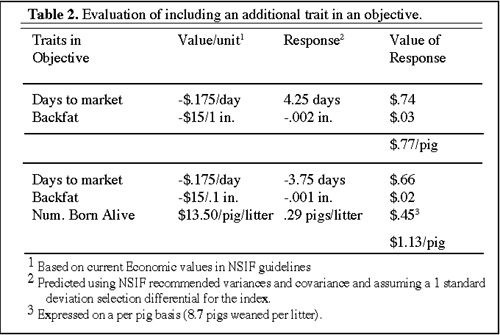
When considering multiple trait improvement, the
correlation among traits is important. Genetic correlations are caused by
two mechanisms, linkage, and pleiotropy. Linkage occurs when the
controlling genes of two traits are located near each other on the same
chromosome and therefore are transmitted from parent to offspring
together.
Pleiotropy is a situation where one gene, or group
of genes, controls more than one trait. Pleiotropy is most obvious for
growth traits. Genes controlling growth tend to do so throughout the
entire growth period. Genes affecting growth early in the growing period
also affect later growth. Therefore, weights at different ages are
positively correlated. Genetic correlations may be positive, which means
as you select to change one trait, the second trait moves in the same
direction (both increase or both decrease). Or, genetic correlations may
be negative, which means the traits respond in opposite directions (one
increases as the other decreases). Correlations among traits must be
considered in assessing the total impact of selection for a trait. As a
trait is altered, performance for all correlated traits change as well.
The net effect of changing a trait is the summation of the changes in the
trait itself and all correlated traits.
Correlations among traits may be exploited to
reduce testing costs. An example is the relationship among growth rate,
backfat, and feed efficiency. These three traits are correlated such that
fast-growing lean animals are more efficient. It is expensive and
difficult to accurately measure feed efficiency directly on individual
animals, but growth rate and backfat can be economically measured.
Therefore, a selection objective of improving feed efficiency can be
achieved by using both growth rate and backfat thickness as selection
criteria. The response due to direct selection for feed efficiency is
greater, but the costs of measurement are also greater. Use of the
correlated information is one method of reducing testing costs while
improving the feed efficiency.
Multiple Trait Selection Criterion
There are three general methods of multi-trait
improvement.
Tandem Selection
Tandem Selection is a method by which a single
trait is used as the
selection criterion for one or more generations. The trait used as the
selection criterion in each generation is rotated among all traits of the
selection criteria in successive generations. Each trait follows in a
tandem fashion until all traits have been used as the selection criterion.
For example, a breeder may have an objective of increasing growth rate,
decreasing backfat, and increasing litter size. In the first generation,
selection would be for the fastest growing hogs. This is followed in
tandem in the second generation by selecting the leanest hogs (lowest
backfat). In the third generation, hogs from the largest litters are
selected. Then a new round of rotation is started.
Tandem selection is frequently described as a
simple method of selection because only one trait must be evaluated in any
generation. The drawback with this method is that some animals with a
greater total number of desirable genes (more closely aligned with the
overall breeding objective) may not be selected because it may be inferior
to other animals in the trait currently being used as the selection
criterion. Also, the greatest response for any trait occurs during those
generations when it is the criterion, hence response is sporadic. In
addition, if there are negative correlations among traits, improvements
achieved by selection for one trait in earlier generations may be
cancelled out by correlated losses in subsequent generations. Tandem
selection is not a recommended method of achieving maximum response to
selection.
Independent Culling Levels
Independent culling levels is a method where
minimum standards of performance are established for each trait in the
criteria. Any animal not satisfying the minimum standard for all traits is
culled.
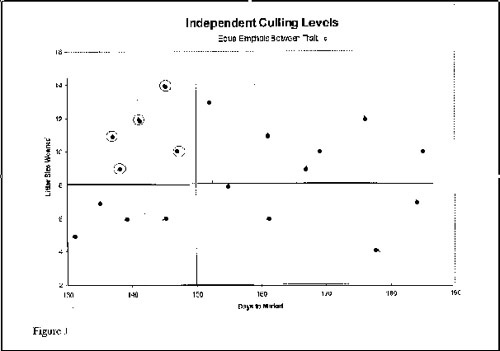
Independent culling levels is a frequently used
method of improvement. It allows simultaneous improvement of traits and
varying emphasis to be placed on traits (Figure 1). Animals in the figures
whose data points are circled are the animals that would be selected. The
relative selection pressure applied to each trait is altered by changing
the culling levels. Figure 2 demonstrates a higher selection intensity for
days to market with a corresponding reduction in pressure applied to
litter size, relative to the selection pressures depicted in Figure 1. The
total number of animals selected by either set of culling levels is the
same. The percent of animals selected by each trait is defined such that
the product of multiplying the percent saved by each criterion is equal to
the final percentage of the herd needed for breeding.
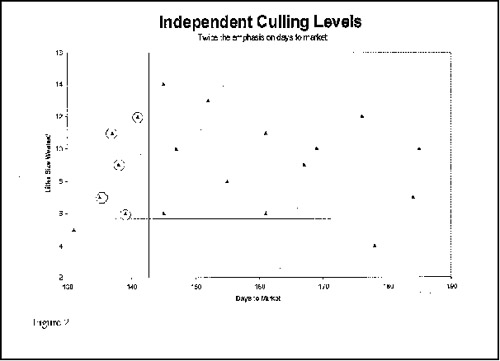
For example, if selection is based on two traits
weighted equally and 25% of the herd is retained for breeding, the culling
level for each trait will select 50% of the animals (50% x 50% = 25%). If
a 2 to 1 emphasis were placed on the traits, 35% of the animals could be
selected on the first trait, but the upper 70% of the animals ranked on
the second trait must be selected to retain 25% of the herd (.35 x .70 =
.25).
One problem with independent culling levels occurs
if the culling rules are applied rigidly. Exceptional performance in one
trait may not offset a minor deficiency in another trait. An animal that
has superior performance for one trait but only average performance for
another may be culled. Many breeders "break the rules" to allow for this
type of situation. The problem is that the breeder must spend considerable
time and effort monitoring the selection system. Independent culling
levels are frequently used in combination with other forms of multi-trait
selection. Physical abnormalities that restrict an animal's ability to
perform as breeding stock are used as a basis for culling prior to final
selection decisions being made on other criteria such as an index of
growth and maternal traits. Care should be taken to insure that only those
traits that affect the economic status of a herd are used as culling
criteria.
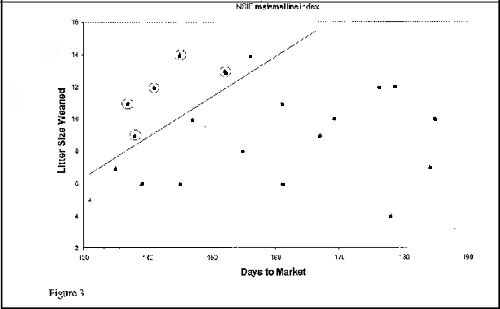
Index Selection
Index Selection is a method where the net values
of all traits of the selection criteria are combined into a single index
value. The index is derived utilizing the heritabilities of the traits,
correlation among traits, and economic value of each trait. An index value
is calculated for each animal based on its performance (performance of
relatives may also be included) for each trait. Selection is then based on
the ranking of individuals according to index value.
The index value is an estimate of the cumulative
value, usually dollar ($) value, of each animal's genetic potential of all
traits in the objective. Index selection has advantages over independent
culling levels in that all traits are improved simultaneously and
differential emphasis can be placed on each trait.
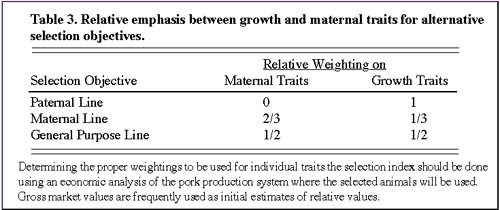
In addition, index selection allows for a superior
level of performance in one trait to compensate for deficiencies in other
traits. Typically, indexes use the relative economic values of traits to
define the selection emphasis applied to each trait. Traits with higher
economic value receive higher emphasis. In Figure 3, a maternal index,
based on the NSIF recommendations1 is presented, Index = 100 + 7 x (Litter
Size) - 1.4 x (Days to Market) where litter size and days to market are
expressed as deviations from the mean. A sow with +2 pigs per litter and
-7 days to market would have an index value of 100 + 7 x (2 pigs) - 1.4 x
(-7 days to market) = 123.8 index units. Sows with the highest index
values are selected. Index Selection is the most efficient of the three
methods for multiple trait improvement.
Determining the Selection Objective
The selection objective includes all traits of
economic importance to the production system where the pigs are used. For
example, if the animals are to be used only to sire market hogs (paternal
line), then those traits (growth rate, leanness, and feed efficiency)
involved in performance of market hogs are most important. However, if
their primary role is to produce replacement females for commercial
production, then maternal traits are of primary importance. However, since
replacement females contribute 1/2 the genetic potential for growth and
leanness of their market hogs, growth traits should not be ignored in
maternal lines. A herd producing stock for use in a rotational breeding
program should have an objective that is intermediate between the paternal
and maternal line. The relative emphasis among traits is shown in Table 3.

When industry-wide selection objectives are
developed, more precise estimates of the economic importance of traits
should be used. A profit function accounting for all inputs and outputs of
the production system in terms of measurable traits is needed to determine
the economic values. Major costs to the production system such as housing
and labor can be represented as a daily charge for each type of facility
in the production system and can be determined as a function of growth
rates for pigs or conception rates for the breeding herd. Other costs,
such as feed, can be based on feed consumption of growing pigs and
maintenance requirements of the breeding herd.
Equation 2 is a profit function appropriate for
the growing-finishing phase of pork production. Line 1 of Equation 2 is
the income from the sale of a market pig. Income is determined by the base
market price adjusted for premiums (or discounts) associated with a leaner
(or fatter) carcass. Line 2 of Equation 1 represents the costs of rearing
the pig in the growing and finishing phase. Costs are determined by
multiplying the time it takes for the pig to reach market weight (growth
rate) by the daily cost of facilities and labor and the feed consumed in
attaining the gain (feed efficiency) by the cost of feed. Line 3 is the
value of the weaned pig. Elements that are biological traits subject to
genetic change are represented by upper case letters. Elements that are
management constraints or represent costs and/or values are represented by
lower case letters. Economic estimates are for a midwestern U.S.
farrow-to-finish market hog production system.
1Performance on litter weight and
backfat depth are included in NSIF Maternal Index. They are omitted here
to simplify graphic presentation.
Determining the Selection Criterion
Ideally, the traits described in the selection
objective are included in
the selection criterion. However, traits in the selection criterion must
be measured on each animal or its relatives. Realistically, the cost of
measuring some traits, either in terms of money or time, may make it
impractical to include them in the selection criterion. Therefore, the
selection criterion may include traits which themselves are of little or
no value but are correlated with traits of high value (NSIF-FS3).
A 21-day litter weight is an example of such a
trait. Because few pigs are sold at 21-days of age, there is little direct
value assigned to the litter's weight. However, 21-day litter weight is
correlated with several traits which are of high economic value and is
therefore useful as part of the selection criterion. Heavy litters at
21-days are produced by sows with good maternal ability. Sows with good
maternal ability have higher pig survival rates and produce adequate milk
to support growth. Pigs from heavy litters tend to be heavy themselves,
are more vigorous, adjust to the post-weaning facilities more readily, and
reach market weight faster. Therefore, litter 21-day weight is an
excellent selection criterion that is easily and inexpensively measured
and an indicator of several traits of high economic value, specifically
pig numbers, survival, and growth rate.
Other instances of traits that may be in the
selection objective but not
in the selection criterion are those that cannot be measured directly on
the individual. Some traits are sex limited. Boars don't bear litters, but their genetic
potential for litter size is still important. Longevity in the breeding
herd is valuable, but can only be recorded when the animal is culled or
dies. Many carcass quality traits are not yet directly observable on the
breeding candidates since they require slaughter. When these traits are
included in the selection objective, the selection criterion should
include correlated sources of information such as other traits and
information on relatives.
After the list of traits to be used as the
components of the selection criterion is developed, using the traits to
identify animals for selection depends on the method of selection used.
With tandem selection, the order in which the traits are to be used is
decided; then animals are selected on one trait in turn by generation. If
independent culling levels are used, the minimum level of performance for
each trait is determined, and all animals not satisfying all standards are
culled. With index selection, the heritabilities and genetic correlations
are combined with the economic value to determine a numeric weighting for
each trait. For each animal, the performance of each trait is multiplied
by the weighting factor and summed to determine the index value. The
animals are ranked on the index value and those with the greatest values
are selected.
The task of developing selection indexes is
greatly simplified when combined with a genetic evaluation system. The
Expected Progeny Deviations (EPD) are calculated considering the genetic
variances and correlations among traits and utilize all available
performance information from relatives to increase the accuracy of the
evaluation. A breeder can simply multiply the EPD of each trait by its
economic value and sum the results. Those animals with highest index
values are the ones expected to have the highest value as parents. With
personal computers and software available today, this computational task
is not as cumbersome as it once was.
Summary
Improving the performance in multiple traits
simultaneously is usually desired in genetic improvement programs. It is
important that only traits of economic importance to the breeder and
customers are included in selection objectives. Expanding the number of
traits in the objective reduces the rate of improvement in individual
traits but may increase overall productivity. Multi-trait improvement
programs account for differences in economic value among traits,
differences in heritability, variation and correlations among traits. All
available information describing the performance of individuals and their
relatives should be utilized. Selection indexes utilizing expected progeny
deviations estimated from performance data of individuals and their
relatives best satisfy these requirements.
Recommended economic values of traits and
selection indexes for paternal, maternal, and general genetic lines are
available in the National Swine Improvement Federation (NSIF) guidelines
for uniform swine improvement programs.
10/99 (2M)
It is the policy of the Purdue University Cooperative Extension Service,
David C. Petritz, Director, that all persons shall have equal opportunity
and access to its programs and facilities without regard to race, color,
sex, religion, national origin, age, or disability. Purdue University is
an Affirmative Action employer.
This material may be available in alternative formats.
1-888-EXT-INFO
http://www.extension.purdue.edu/extmedia/menu.htm










